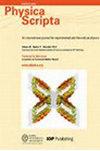用于薄膜太阳能电池的磁控溅射 Sb2Se3 吸收层的热诱导表面成分和形貌变化研究
IF 2.6
3区 物理与天体物理
Q2 PHYSICS, MULTIDISCIPLINARY
引用次数: 0
摘要
硒化锑(Sb2Se3)是开发可持续薄膜太阳能电池技术最有前途的半导体材料之一。硒化锑(Sb2Se3)具有优异的光学和电学特性,最近引起了人们对其在薄膜太阳能电池中潜在应用的关注。在这项研究中,使用直流(DC)磁控溅射技术沉积的 Sb2Se3 薄膜在 150 至 450 °C 的温度下进行了后退火处理,没有额外的硒供应。在没有额外硒供应的情况下,研究了后退火温度对薄膜表面成分和物理特性的影响。总体评估结果表明,后退火温度能有效改变 Sb2Se3 吸收薄膜的物理性质。我们进一步观察到,后退火工艺改善了结晶,热处理温度对优先取向有相当大的影响。在高的后退火温度(> 350 °C)下,薄膜的表面形态表现出结构变形。根据光学和电学表征,Sb2Se3 薄膜的光学能隙和电阻率分别随着后退火温度的升高而降低。根据 XPS 结果,后退火温度的变化导致了薄膜表面成分的变化。有关 Sb2Se3 薄膜生长的研究结果表明,存在一个中间生长温度,可以优化 Sb2Se3 薄膜的生长。这项研究的结论可以指导薄膜太阳能电池应用中具有所需结晶度、表面形态和成分的 Sb2Se3 薄膜的生长。本文章由计算机程序翻译,如有差异,请以英文原文为准。
Investigation of thermally induced surface composition and morphology variation of magnetron sputtered Sb2Se3 absorber layer for thin film solar cells
One of the most promising semiconductor materials for the development of sustainable thin-film solar cell technology is antimony selenide (Sb2Se3). Its excellent optical and electrical properties have drawn attention lately for potential application in thin-film solar cells. In this study, Sb2Se3 films deposited using the direct current (DC) magnetron sputtering technique have been subjected to a post-annealing process without an extra selenium supply at temperatures between 150 and 450 °C. Without an extra selenium supply, the impact of post-annealing temperature on the surface composition as well as the physical properties of the fabricated films was investigated. The overall evaluations revealed that the post-annealing temperature is highly efficient in altering the physical properties of the Sb2Se3 absorber thin films. We further observed that the post-annealing process improved the crystallization and the heat treatment temperature quite affected preferential orientation. The surface morphology of films exhibited structural deformation at high post-annealing temperatures (> 350 °C). According to optical and electrical characterizations, respectively, the optical energy gap and the resistivity of Sb2Se3 films reduced with an increment in the post-annealing temperature. Based on the XPS result, the variation in temperature of post-annealing led to a change in the surface composition of the films. The findings on the growth of Sb2Se3 thin films indicate the existence of an intermediate growth temperature that permits the growth of Sb2Se3 films to be optimized. The study’s conclusions can serve as a guide to the growth of Sb2Se3 thin films with the desired crystallinity, surface morphology, and composition for thin film solar cell applications.
求助全文
通过发布文献求助,成功后即可免费获取论文全文。
去求助
来源期刊

Physica Scripta
物理-物理:综合
CiteScore
3.70
自引率
3.40%
发文量
782
审稿时长
4.5 months
期刊介绍:
Physica Scripta is an international journal for original research in any branch of experimental and theoretical physics. Articles will be considered in any of the following topics, and interdisciplinary topics involving physics are also welcomed:
-Atomic, molecular and optical physics-
Plasma physics-
Condensed matter physics-
Mathematical physics-
Astrophysics-
High energy physics-
Nuclear physics-
Nonlinear physics.
The journal aims to increase the visibility and accessibility of research to the wider physical sciences community. Articles on topics of broad interest are encouraged and submissions in more specialist fields should endeavour to include reference to the wider context of their research in the introduction.
 求助内容:
求助内容: 应助结果提醒方式:
应助结果提醒方式:


